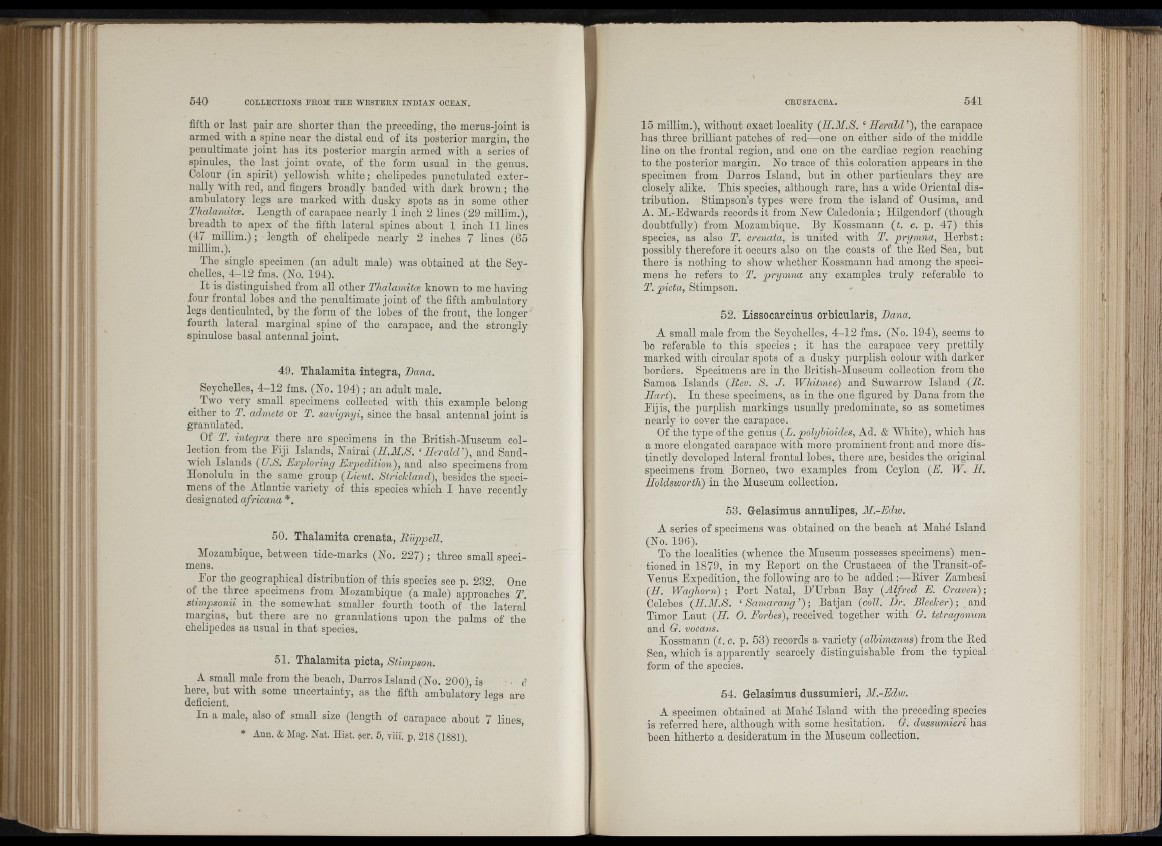
I
I i
t■ etlf !-i ■
-I.
M
¡ir'“
fifth or last jiair are shorter than the preceding, the merus-joint is
armed with a spine near the distal end of its posterior margin, the
penultimate joint has its posterior margin armed ivith a scries of
spinules, the last joint ovate, of the form usual in the genus.
Colour (in spirit) yellowish w h ite ; chelipedes punctulated externally
svith red, and fingers broadly banded witb dark brown; tbe
ambulatory legs are marked with dusky spots as in some other
Thalamita;. Length of carapace nearly 1 inch 2 lines (29 millim.),
breadth to apex of the fifth lateral spines about 1 inch 11 lines
(47 millim.); length of chelipede nearly 2 inches 7 lines (65
millim.).
Tbe single specimen (an adult male) was obtained at tbe Seychelles,
4 -12 fms. (No. 194).
I t is distinguished from all other Thalamita; known to me having
four frontal lobes and the penultimate joint of tbe fifth ambulatory
logs denticulated, by the form of tbe lobes of the front, tbe longer
fourth lateral marginal spine of tbo carapace, and the strongly
spinulose basal antennal joint.
49. Thalamita integra, Dana.
Seychelles, 4 -1 2 fms. (No. 194) ; an adnlt male,
^ Two very small specimens collected witb this example belong
either to T. admete or T. savignyi, since tbe basal antennal joint is
granulated.
Of T. integra there are specimens in the British-Aluseum collection
from tbe Fiji Islands, Nairai {H.Al.S. ‘Herald’), and Sandwich
Islands (U.S. Exploring Expedition), and also specimens from
Honolulu in the same group (Lieut. Strickland), besides the specimens
of tbe Atlantic variety of tbis species which I have recently
designated africana *,
50. Thalamita crenata, Rüppell.
Alozamhique, between tide-marks (No. 227) ; three small specimens.
For tbe geographical distribution of this species see p. 232. One
of the three specimens from Alozamhique (a male) approaches T.
stimpsonii in the somewhat smaller fourth tooth of tbe laterai
margins, but there are no granulations upon tbe palms of tbe
chelipedes as usual in th at species.
51. Thalamita picta, Stimp son.
A small male from the beach, Darros Island (No. 200), is - . d
here, but witb some uncertainty, as tbe fifth ambulatorv legs are
deficient.
In a male, also of small size (length of carapace about 7 lines,
* Ann. & Mag. Nat. Hist. ?er. 5, viii. p, 218 (1881).
15 millim.), without exact locality (H.M.S. ‘ Herald ’), tbe carapace
has three brilliant patches of red—one on either side of tbe middle
line on the frontal region, and ono on the cardiac region reaching
to tbe posterior margin. No trace of tbis coloration appears in tbe
specimen from Darros Island, but in other particulars they are
closely alike. Tbis species, although rare, has a wide Oriental distribution.
Stimpson’s types were from tbe island of Ousima, and
A. Al.-Edwards records it from New Caledonia; Hilgendorf (though
doubtfully) from Alozamhique. By Kossmann (t. c. p. 47) this
species, as also T. crenata, is united witb T. prymna, Herbst :
possibly therefore it occurs also on tbe coasts of the lied Sea, but
there is nothing to show whether Kossmann had among tbe specimens
he refers to T. prymna any examples truly referable to
T. picta, Stimpson.
52. Lissocarcinus orbicularis, Dana.
A small male from the Seychelles, 4 -12 fms. (No. 194), seems to
bo referable to this species ; it has the carapace very prettily
marked with circular spots of a dusky purplish colour with darker
borders. Specimens are in the British-Aluseum collection from tbo
Samoa Islands (Bev. S. J. Whitmee) and Suwarrow Island (B.
Hart). In these specimens, as in the one figured by Dana from the
Eijis, the purplish markings usually predominate, so as sometimes
nearly to cover tbe carapace.
Of tbe type of tbe genus (L. polyhioides, Ad. & White), which has
a more elongated carapace with more prominent front and more distinctly
developed lateral frontal lobes, there are, besides the original
specimens from Borneo, two examples from Ceylon (E. W. H.
Holdsworth) in tbo Museum collection.
53. Gelasimus annulipes, AI.-Edw.
A series of specimens was obtained on tbe beach at Alahe Island
(No. 196).
To the localities (whence tbe Aluseum possesses specimens) mentioned
in 1879, in my Eeport on tbe Crustacea of the Transit-of-
Yenus Expedition, tbe following are to be added :—Eiver Zambesi
(H. Waghorn); Port Natal, D’Urban Bay (Alfred E. Graven);
Celebes (H.Al.S. ‘ Samarang ’) ; Batjan (coll. Dr. Bleeker) ; and
Timor Laut (H. 0. Forhes), received together witb G. tetragonum
and G. vocans.
Kossmann (t. c. p. 53) records a variety (cdhimanus) from tbe Bed
Sea, wbicb is apparently scarcely distinguishable from tbe typical
form of tbe species.
54. Gelasimus dussumieri, AI.-Edw.
A specimen obtained at Alabe Island Avitb tbe preceding species
is referred here, although witb some hesitation. G. dussumieri has
been hitherto a desideratum in the Museum collection.
I ; ti;
n-
: , I.
'I IJ